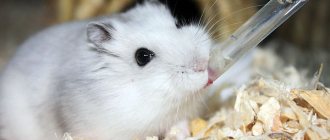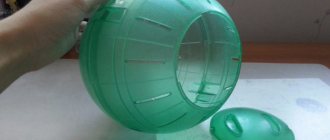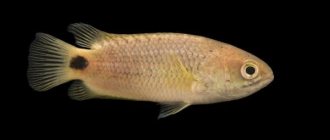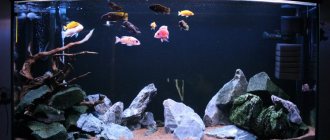Reproduction occurs by spawning, but the parents do not care for the offspring.
On the contrary, adults readily eat the eggs, so inexperienced aquarists may not even notice the spawning . Given the right conditions, Danios can reproduce all year round, so breeders have successfully produced offspring every two weeks.
Features and varieties
The ideal volume of an aquarium for breeding zebrafish is more than 10 liters, and an elongated shape is preferable, since the fish are very nimble and need a lot of space to swim. The optimal number of fish to keep at one time is 7 or 8. The fish are schooling, and this way they will be as comfortable as possible. It is important that there is always fresh water in the aquarium. Experts advise replacing 15% of the fluid with clean fluid every week.
Danio is an almost omnivorous fish; the main thing is that the feed fraction is not too large. If you plan to organize the breeding of fish in captivity, it is recommended to include live food (daphnia, bloodworms, etc.) in the diet. Puberty occurs between 5 and 8 months of age.
The most popular types of zebrafish in Russia, which are bred at home:
- Rerio (zebra). Striped fish of blue and yellow color, no more than 70 mm in length. In 2003, they served as the basis for the development of a new species - zebrafish glo with a fluorescent glow.
- Pink. Such zebrafish can be kept freely in a community aquarium. The height of each individual is no more than 6 centimeters.
- Leopard print. Size – no more than 5 centimeters. The body color is spotted, in accordance with the name.
- Orange-finned. This type of zebrafish has beautiful yellowish-orange fins.
- Khopra or firefly. The smallest subspecies, the length of each fish is less than 30 mm.
- Dangila. One of the largest varieties, reaching 10 centimeters in length.
Despite the external differences, all species are similar in needs and behavior, so the instructions for breeding zebrafish in an aquarium can be called universal.
Diseases
An attentive and caring aquarist must be prepared for the fact that his beloved pets may suddenly become ill. The following diseases are typical for zebrafish:
- Plistophorosis is a disease that manifests itself in the form of light spots on the body of the fish, which over time turn into ulcers. The fins begin to ruffle, the fish move in an unusual way and refuse to eat. To cure pets, use Trichopolum or Erythrocycline, the aquarium, soil and decorations are disinfected.
- Trichodinosis - ciliates are considered the source of the disease. Symptoms of trichodinosis appear in the form of gray flakes on the body of fish, pets begin to rub against walls and decorations. To save the phenotypes, table salt is added to the water, the temperature is raised to 30C, and aeration is increased. If the fish become worse, the infected individuals are destroyed, and the remaining pets are quarantined.
Danio is a genus of fish with many varieties of different colors and sizes, among which every aquarist will find a pet to their liking. Having acquired a flock of bright and active fish, you should follow the rules of care and maintenance of the phenotypes in order to eliminate the likelihood of developing diseases.
How to find the difference between a male and a female?
Zebrafish fry are very similar to each other, it is almost impossible to distinguish them. But in adults the differences are more obvious. Males are smaller and slimmer. Females have a round abdomen. In addition, males are brighter in color and have strong fins. Females are noticeably paler.
If the female's abdomen is swollen, this means that she is ready for reproduction - she releases pheromones to attract a potential partner. Males also secrete hormones that actively stimulate ovulation in “girls”. This is accomplished through the process of releasing homogenate and gonads from the seminal glands into the water. Boys should be in the same tank with girls for eight hours.
Gender difference
Before spawning a couple of fish, you need to be able to distinguish boys from girls. It is possible to distinguish the sex of those fish that have reached 7-8 months, since in zebrafish that are too young, the body has not yet fully formed. To distinguish a male from a female, pay attention to the following features:
The male pink danio is smaller than the female and has a brighter color.
- Coloration - Male pink danios typically have brighter stripes on their bodies.
- Body – Males have a slimmer build and shorter body length.
- Anal fin - Some breeders use the anal fin to determine sex. In females it is longer and has a more rounded shape.
There is another way - visual. If you monitor the behavior of the aquarium inhabitants, you will notice that the males have much greater speed and constantly circle around the female .
How to recognize readiness for reproduction?
The aquarium zebrafish becomes sexually mature between five and eight months of age. By this point, females reach a length of 2.4-2.5 cm, and males - about 2.3 cm. During the mating period, pairs are inseparable from each other and practically do not break away from the fertilization process. The abdomen of females becomes noticeably more rounded.
The season is not so important when it comes to reproduction. Danios show themselves to be fruitful at any time of the year. Plentiful and high-quality nutrition is much more important.
Compatibility
Peaceful zebrafish are well compatible with other fish. Due to their high degree of adaptation to any conditions, they become excellent neighbors for inhabitants of other countries, such as titers and rainbows. Get along well:
- neons;
- guppy;
- gourami;
- catfish.
Zebrafish are schooling fish and when kept in numbers less than 8, they experience stress, which is why they become lethargic and inactive. The fish in the group are bright and active. A school of zebrafish in numbers of up to 8–10 individuals exhibits aggressiveness towards neighbors. Increase the population to 12-14 to avoid fights.
Veiled does not get along with barbs.
Not compatible:
- goldfish;
- acne;
- cichlids;
- discus.
Where to spawn?
There are two options for places for spawning and storing eggs.
The first is in a common aquarium. It should have enough plants and various shelters, however, there is still a high probability that the fish will eat most of their offspring.
The second is in the spawning area. This is a separate aquarium for 20-40 liters, where at a distance of three centimeters from the bottom there is a special separator mesh that fits tightly to the walls. The laid eggs fall through the mesh, and there should be no gaps, otherwise the adults will be able to squeeze through.
Sometimes, instead of a net, spawning soil or balls with a diameter of a centimeter or more are used. If the eggs get lost among the balls/pebbles, it will be difficult for parents to enjoy them.
Tips for preparing zebrafish for spawning
The instructions instruct you to first separate pregnant females and males, distributing them into different containers. It is important to feed your fish with high quality food; ask around at pet stores. The best options are bloodworms, tubifex or daphnia.
As soon as the female’s abdomen becomes very round, it means she is ready to spawn.
Desirable conditions for keeping spawning females:
- water temperature - depends on the season (in summer from +20 to +25, in winter from +17 to +22);
- liquid acidity (pH) – from 6 to 7.5;
- water hardness – maximum 10 (to reduce the hardness level, you can dilute the liquid with distilled water).
The water must be enriched with oxygen, and a plant substrate must be placed at the bottom (under the net), which includes: glitter, pinnate, etc. After waiting one or two weeks, the fish can be moved to the spawning area. Relocation in groups of 5 or more individuals is acceptable.
Females are comfortable laying eggs in shelters, for example, from plants - both long-stemmed ones, mosses or ferns. The most suitable options: hornwort, Singapore moss, elodea, Java moss, horned ceratopteris, winged fern.
Zebrafish Spawning Process
A large belly in a female means she is completely ready to lay eggs. It is worth noting that zebrafish are not viviparous fish, as many people think.
Transplanting fish ready for breeding should be done in the evening and with the lights off, so as not to cause them irreparable stress. If all is well, spawning will begin by morning. In more rare cases, you need to wait another 1-2 days, and do not feed the fish during this time. If spawning has not started after two days, it is permissible to throw in a little food and continue to wait.
If there is still no result, you can put the zebrafish back into the general aquarium and repeat all of the above in a couple of weeks.
At first glance, spawning looks like the male is chasing a pregnant female around the tank. Nature has thought of everything - in this way he helps her shed eggs. By the way, there shouldn’t be a lot of water in the container - a level of 10 centimeters is enough. This is due to the fact that in nature the female is accustomed to spawning in the very depths of the water.
Why don't they reproduce?
Both beginners and experienced aquarists may encounter a common problem: zebrafish do not produce offspring despite all their efforts.
- Genetic pathologies, injuries. Infertility can be primary or secondary: either the female never became pregnant at all, or over time she stopped spawning.
- Fungal or bacterial diseases.
- Immaturity of the reproductive system. The age of puberty in zebrafish is quite vague: one fish is ready to reproduce as early as 5 months, while another needs a couple more months to grow.
- Old age.
- Incorrect timing or lack of interest in the fish. The inhabitants of the aquarium are living creatures; they cannot mate on cue. It’s worth waiting a little or adding a few more individuals to the aquarium.
- Too cool or stagnant water. Increasing the temperature and changing water are prerequisites for the appearance of readiness for reproduction.
- Stress due to overcrowding. In cramped conditions, fish have a hard time, and the sexual instinct is replaced by anxiety.
- Poor nutrition. In order for the female’s body to prepare for pregnancy, it is necessary to give her live food.
- Fossil of eggs in the abdomen of a female.
There is one more nuance that is typical for beginners in aquarium keeping: same-sex fish can live in the same vessel. This is a clear reason that determines the impossibility of reproduction. It is easy to correct the situation: transfer some of the pets to another aquarium and add zebrafish of the same species, but of the opposite sex.
How to care for zebrafish eggs
It is very important to pay a lot of attention to the proper care of caviar - the slightest infection or fungus will lead to its death. Generally accepted safety precautions:
- Shade the tank.
- Add erythromycin to the liquid (to do this, grind the medicine to a powder).
- Instead of erythromycin, iodine can be used for disinfection (three drops per ten liters of water).
- Some eggs may begin to turn white a couple of hours after spawning. This means that they are infected with a fungus. You should immediately remove them from the aquarium using tweezers so that the rest do not have time to become infected.
In addition, you need to change part of the water in the tank with zebrafish eggs every day (from 10 to 25 percent of the volume). The clean liquid should not differ in temperature from the old one.
How to care for baby zebrafish
When the larvae finally crawl out of the eggs, for the first few days they will simply sit motionless on any surfaces they can find in the aquarium. The larvae have a so-called yolk sac - this is what feeds them for the first time. After 5-6 days, this sac dissolves, and the fish become more active - looking for food. Now they can be called fry with a clear conscience.
At first, the fry need to be fed with liquid food - special formulations are sold in pet stores. The basis of the diet is ciliates, and ready-made food is only a supplement to them. It usually contains small crustaceans or plankton.
The fry grow extremely quickly, they will soon reach a length of 15 mm - this is a sign that they can be moved to a common tank. After six weeks, their approximate height will be 24 mm.
Substrate selection
The female prefers a specific substrate for laying eggs. In studies with domestic and wild specimens in separate cages, it was found that females prefer gravel bottoms rather than muddy bottoms (Spence et al., 2007b). Territorial males also tend to defend bottom gravel areas. This behavior is explained by the much better survival of eggs on a solid substrate, where they are supplied with oxygen and also protected from cannibalism. In laboratory conditions, preferences for plant thickets were also revealed, although the latter do not affect the safety of the masonry in any way. However, plants make a significant contribution to increasing larval survival; they provide attachment sites and help reach the surface for swim bladder inflation (Laale, 1977). In natural areas where zebrafish are the predominant species, such as floodplain ponds, the substrate is often muddy, and the fish wade to spawn in shallow waters among vegetation that protects them from predators (Engeszer et al., 2007; Spence et al., 2007b) . Thus, the choice of producers is aimed at places with better water circulation, where there are no predators. Finding spawning areas is one of the few mechanisms in species that do not exhibit parental care. It helps to increase the survival rate of clutches and larvae.
——
based on review by Rowena Spence, Gabriele Gerlach, Christian Lawrence and Carl Smith. The behavior and ecology of the zebrafish, Danio rerio. Biol Rev Camb Philos Soc. 83 (1): 13-34. 2008.
Literature review:
Zebrafish spawning repeat
When one or a week and a half has passed after the first spawn, it is important to repeat the procedure again. If you take this lightly, the caviar will become overripe, lose its life-giving properties, and fry will no longer appear from it. It also happens that the female does not want to spawn overripe eggs at all, which can be harmful to her health. In nature, each zebrafish produces five to six spawns in a row.
The easiest way to find out that eggs are overripe (or, on the contrary, not yet ripe) is by the behavior of the “girl” zebrafish. After moving to the spawning area, she behaves restlessly and constantly hides from the male in shelters and plants.
If the female is pregnant, but does not want to lay eggs on her own, then it is important to help her with this in a timely manner.
If the female’s belly is very rounded and clearly full of eggs, then she still does not want to spawn, then it is necessary to help her shed overripe eggs. This is done like this: the fish is carefully wrapped in wet cotton wool and held tightly with two fingers of the left hand. Then, using the index finger of the right hand, squeeze the caviar out of it. If the procedure is carried out correctly and the zebrafish is not harmed, it will be ready to spawn again within a week.
How to dilute at home, instructions for beginners
Like fertilization, danio spawning is quite simple. Aquarists should only take care of the safety of the offspring, since adults immediately after spawning tend to eat most of the eggs . Let's look in more detail at how fish reproduce in an aquarium.
Where to breed?
Usually a separate aquarium is used as a spawning ground, since in general it is difficult to monitor the eggs, and subsequently the fry.
In a separate aquarium
For spawning, a separate aquarium is most often equipped, the volume of which is 20-40 liters.
An important condition is the presence of a special mesh, which is located at a distance of 2-3 cm from the bottom. It should fit tightly to the walls so that adult Danios cannot squeeze through to the eggs that have fallen to the bottom.
Some aquarists place special spawning soil, balls, tangled wires and other objects on the bottom that can hide the eggs from hungry parents.
Of course, the spawning area must be equipped with a compressor, a small filter, a heater and a lamp. If desired, you can place plants with long shoots (for example, elodea).
After placing all the necessary items, clean water is poured into the aquarium and left for several days. Thus, preparation of the spawning area must be carried out in advance.
In a common aquarium
An aquarium with a net is necessary so that the fry can hide behind it.
Sometimes spawning is carried out in a general aquarium if there are many different shelters and plants in it.
However, most of the eggs will still be eaten - if not by the Danios themselves, then by other inhabitants of the tank. With this method, you should not expect a large offspring, so it is still better to avoid spawning in a community aquarium .
In a three-liter jar
In some cases, spawning can take place even in an ordinary three-liter jar. As a rule, this method is used by those aquarists for whom it is important to preserve the health of the females, but raising offspring is not part of their plans.
Preparation
Partial preparation for spawning was described earlier, but novice aquarists should read the detailed recommendations again.
First of all, you need to take care of the correct water parameters in the tank where the spawning will take place:
- temperature depends on the time of year (in summer 20-25 degrees, in winter 17-22);
- acidity – from 6 to 7.5 pH;
- hardness – maximum 10 mmol/l (if your water is too hard, it can be diluted with distilled water).
Important! You need to monitor the purity of the water and change approximately 15-20% of its volume every week.
An aerator must be installed in the spawning area, and plants (sparkleweed, pinnate, and others) are placed on the bottom. A net or other items necessary to protect the caviar are placed on top. The spawning area itself can be planted with various plants with long stems, ferns or moss, which create a certain comfort and facilitate the spawning process. Typically, aquarists use hornwort, elodea, Singapore or Java moss.
The aquarium itself must hold at least 10 liters of water. It is better if it is rectangular, since Danios are very active and also make constant rapid movements during spawning. Fish ready for spawning must be carefully moved into the aquarium, and one group should contain at least 5 individuals, optimally 7 or 8 fish.
Process
The male will chase the female - this is normal.
Large-bellied females should be placed in a spawning tank before spawning. Transplantation is carried out in groups (as already mentioned, from 5 to 8 fish).
Please note that spawning is carried out in the presence of males, and there should be 2 times more males than females (for example, 2 females and 4 males). Beginning aquarists have difficulty determining the sex of an individual; if such a situation arises, we recommend reading an educational article on how to distinguish a female Danio from a male, which discusses the main signs of sexual differences in fish.
If there are more pregnant females, then some of them are left in a common aquarium, and then they are swapped with those who have already spawned.
The transplant itself is carried out in the evening with the lights off, so as not to cause severe stress to the fish. If everything went well, then spawning begins in the morning. From the outside, this process looks like the males are aggressively chasing and pushing pregnant females. In fact, the males perform light pokes on the abdomen of the females, which helps them get rid of the eggs. If there are not enough males in the aquarium, then spawning will be difficult.
An important condition for successful spawning is a low water level (about 10 cm). The fact is that in nature Danios spawn almost at the very bottom, so this trick will make the spawning process easier.
Repeating the process
Inexperienced aquarists often transplant spawned females into a community aquarium, thinking that the spawning is over. In fact, after 1-1.5 weeks it is necessary to carry out another spawning, since in natural conditions Danios produce several eggs in a row.
If conditions for spawning are not provided (a separate aquarium and the presence of males), then the eggs may become overripe and the fry will not be able to develop from them. Sometimes the female does not want to spawn the remaining eggs at all, which threatens her health.
If the eggs are overripe (and sometimes it happens that they are not yet ripe), then the female will hide from the male. Otherwise, repeated spawning will take place in the same way as the first spawning.
What to do if spawning fails?
Sometimes there is a delay in spawning, and in this case it is necessary to leave the females and males in the spawning area for a couple of days, giving them food.
If it is obvious that the fish is full of eggs, but for some reason it cannot get rid of the eggs, then you need to come to the rescue.
Try carefully wrapping the fish in wet cotton wool and holding it firmly with the thumb and index finger of your left hand. Using the index finger of your right hand, gently press on the abdomen, squeezing out the calf. If everything is done correctly, and Danio is not harmed, then after 7-10 days she will be ready to spawn again.
If it was not possible to achieve spawning, then the pregnant females need to be placed in a common aquarium, and then all of the above should be repeated after a couple of weeks.
Is there a difference in breeding between zebrafish species?
Check out some of the tips for successfully breeding different types of zebrafish:
- Pink danios definitely need a separate aquarium for spawning. In addition, you should take into account the fact that for breeding one female pink zebrafish needs two males at once.
- Spawning of the leopard zebrafish lasts for two whole months, and the most interesting thing is that throughout this time the pair of fish remains faithful to each other.
- The situation is similar with golden danios, and they can keep their pair not only for the spawning period, but also for the rest of their lives.
Finally, I would like to give a couple of useful tips: if fish suddenly, unexpectedly for you, began to spawn in a common aquarium, it is not too late to immediately put them in a separate tank, as there is less chance that adults will feast on caviar. Imitating rain works well (adding cool water to the aquarium); in such “weather” zebrafish reproduce much easier and more actively.
Don't be upset if breeding doesn't work out the first time. Zebrafish are not machines, but living beings, so things don't always go according to plan.
Nuances you need to know
It would seem that the given characteristics are quite sufficient to unambiguously establish the sex of a particular individual. In reality, these differences are quite difficult to notice, especially for inexperienced aquarists. The situation is further complicated by the fact that Danios are very mobile fish, so examining them is very problematic . In addition, certain nuances should be taken into account:
- the fish must not only be sexually mature, but also approximately the same in age (for example, a two-month-old “girl” cannot be distinguished from an adult “boy”);
- It is important to ensure regular and balanced feeding, as otherwise all individuals become emaciated, pale and lethargic.
Beginners are recommended to purchase several Danios so that they immediately form a school, and it is better to buy adult fish. If you plan to breed them, it is important to initially understand the sexual composition of the flock.











